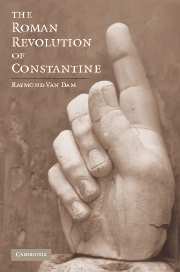Book contents
- Frontmatter
- Contents
- PREFACE
- ABBREVIATIONS
- Map
- Introduction: AUGUSTUS AND CONSTANTINE
- SECTION I A ROMAN EMPIRE WITHOUT ROME
- SECTION II A GREEK ROMAN EMPIRE
- 5 CONSTANTINE'S DIALOGUE WITH ORCISTUS
- 6 “THE MOST HOLY RELIGION”: PETITIONING THE EMPEROR
- 7 “THE ROMAN LANGUAGE”: LATIN AND THE GREEK EAST
- 8 FALLING WATER
- SECTION III EMPEROR AND GOD
- Epilogue: ONE EMPEROR
- APPENDIX 1 HISPELLUM: DATE, TEXT, AND TRANSLATION
- APPENDIX 2 ORCISTUS: DATES, TEXT, AND TRANSLATION
- EDITIONS AND TRANSLATIONS
- BIBLIOGRAPHY
- INDEX
5 - CONSTANTINE'S DIALOGUE WITH ORCISTUS
Published online by Cambridge University Press: 05 June 2012
- Frontmatter
- Contents
- PREFACE
- ABBREVIATIONS
- Map
- Introduction: AUGUSTUS AND CONSTANTINE
- SECTION I A ROMAN EMPIRE WITHOUT ROME
- SECTION II A GREEK ROMAN EMPIRE
- 5 CONSTANTINE'S DIALOGUE WITH ORCISTUS
- 6 “THE MOST HOLY RELIGION”: PETITIONING THE EMPEROR
- 7 “THE ROMAN LANGUAGE”: LATIN AND THE GREEK EAST
- 8 FALLING WATER
- SECTION III EMPEROR AND GOD
- Epilogue: ONE EMPEROR
- APPENDIX 1 HISPELLUM: DATE, TEXT, AND TRANSLATION
- APPENDIX 2 ORCISTUS: DATES, TEXT, AND TRANSLATION
- EDITIONS AND TRANSLATIONS
- BIBLIOGRAPHY
- INDEX
Summary
In september 324 constantine finally defeated licinius and acquired control over the provinces surrounding the eastern Mediterranean. With this victory he had eliminated his last imperial rival and reunited the Roman empire. Constantine had not been in the East for almost twenty years, ever since he had left Nicomedia in mid-305 to join his father in Gaul. Now he was back at Nicomedia to accept Licinius' surrender. He quickly initiated a whirlwind of activity to establish his authority as the emperor in the East and his reputation as a patron of Christianity. Only two months later he consecrated the site of Byzantium in preparation for its transformation into the new capital of Constantinople. During the winter or perhaps in the spring of 325, he traveled across central Asia Minor twice, to and from Antioch. In May and June he participated in the large council of bishops that met at Nicaea. He then remained in or near Constantinople and Nicomedia until the spring of 326, when he traveled to Italy.
During Constantine's journeys locals along the road in Asia Minor would have had firsthand opportunities to meet him and members of his entourage, or at least learn about his preferences. The accession of a new emperor offered a propitious opportunity for cities and individuals to present petitions and make requests for new honors, new titles, and new amenities.
- Type
- Chapter
- Information
- The Roman Revolution of Constantine , pp. 150 - 162Publisher: Cambridge University PressPrint publication year: 2007

